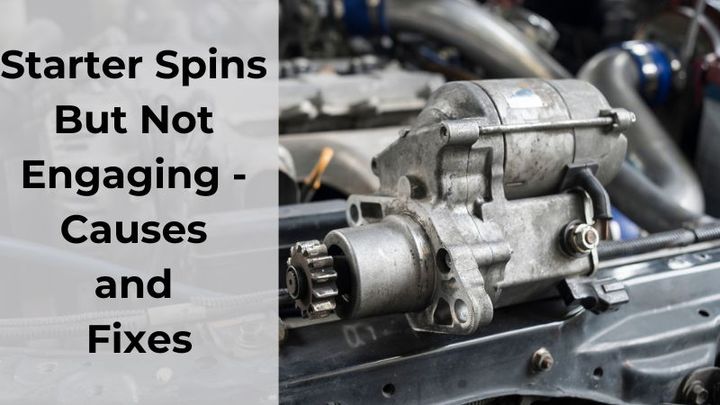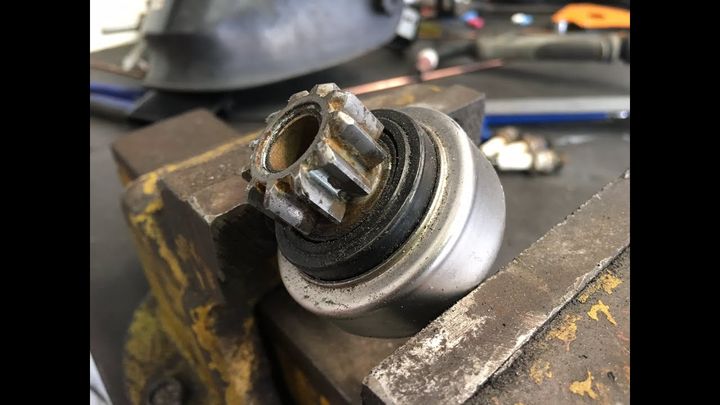


When you turn the key or press the start button, and the starter spins but fails to crank the engine, it can be a frustrating experience. This issue is often caused by a problem with the starter system, preventing it from properly engaging with the engine's flywheel. In this article, we'll explore the common causes, diagnostic steps, and potential solutions to help you get your vehicle back on the road.

The starter system is responsible for initiating the engine's combustion process. It consists of several key components that work together to crank the engine:
| Component | Description |
|---|---|
| Starter Motor | An electric motor that provides rotational force to crank the engine. |
| Starter Solenoid | An electromagnetic switch that allows power to flow from the battery to the starter motor. |
| Starter Bendix | A small gear that meshes with the engine's flywheel ring gear. |
| Flywheel Ring Gear | A toothed ring on the engine's flywheel that engages with the starter bendix. |
The starter system operates as follows:
When you turn the ignition key or press the start button, the starter solenoid receives power from the battery.
The energized solenoid extends the bendix, allowing it to mesh with the flywheel ring gear.
The starter motor spins, turning the engine's crankshaft and initiating the combustion process.
Several factors can prevent the starter system from properly engaging with the engine's flywheel:
The starter solenoid is responsible for pushing the bendix outward to engage with the flywheel ring gear. If the solenoid is defective, it may not extend the bendix fully, causing the starter to spin freely without turning the engine over.
Possible causes:
Worn or stuck plunger
Electrical issues (loose connections, faulty relay, wiring problems)
The bendix is a small gear that meshes with the flywheel ring gear. If its teeth are worn or damaged, it may not engage properly, causing the starter to spin without cranking the engine.
The starter motor requires significant electrical power to operate and engage the flywheel. If the battery voltage is too low, the starter may not have enough power to fully extend the bendix and engage the flywheel ring gear, even though it can still spin.
Potential causes:
Aging battery
Electrical drain (faulty alternator, excessive accessories)
Loose or corroded battery connections
If the teeth on the engine's flywheel ring gear are excessively worn or damaged, the starter bendix may not mesh properly, causing it to spin freely without turning the engine over.
Loose or corroded wiring connections between the battery, starter solenoid, and starter motor can prevent the starter from receiving sufficient electrical power, leading to a lack of engagement with the flywheel.
To accurately diagnose the cause of the non-engagement issue, follow these steps:
Visual Inspection: Inspect the starter motor, solenoid, wiring connections, battery terminals, and flywheel ring gear for signs of damage, wear, or corrosion.
Battery Testing: Check the battery's voltage and cranking capacity using a voltmeter or a battery load tester.
Starter Circuit Testing: Use a multimeter or a dedicated starter circuit tester to check for voltage drops across the starter circuit components.
Starter Removal and Bench Testing: If necessary, remove the starter motor and perform a bench test to isolate the issue.
Flywheel Ring Gear Inspection: Inspect the flywheel ring gear for excessive wear, damage, or misalignment.
Wiring Inspection and Repair: Inspect all wiring connections, and repair or replace any faulty wiring.
Once the root cause is identified, you can consider the following repair and replacement options:
| Option | Description |
|---|---|
| Starter Motor Replacement | Replace the entire starter motor assembly if it's faulty or beyond repair. |
| Starter Solenoid Replacement | Replace the starter solenoid independently if it's the culprit. |
| Bendix Replacement | Replace the starter bendix (drive gear) if it's worn or damaged. |
| Flywheel Ring Gear Repair/Replacement | Repair or replace the flywheel ring gear if it's excessively worn or damaged. |
| Battery Replacement or Charging | Replace or recharge the battery if low voltage is the issue. |
| Wiring Repair or Replacement | Repair or replace any faulty wiring connections. |
To help prevent starter motor non-engagement issues and ensure reliable starting performance, follow these maintenance practices:
Regular battery maintenance
Periodic wiring inspection
Starter motor lubrication (if applicable)
Flywheel ring gear inspection during routine maintenance
Proper installation and alignment of the starter motor
Electrical system maintenance (alternator, etc.)
By addressing any issues promptly and following proper maintenance practices, you can extend the life of your starter motor system and minimize the risk of non-engagement problems.
When your car's starter spins but fails to engage the engine's flywheel, it can be a frustrating experience. However, by understanding the common causes, following the diagnostic steps, and considering the appropriate repair or replacement options, you can resolve the issue and get your vehicle back on the road. Regular maintenance and timely repairs are crucial to ensuring reliable starting performance and preventing further damage to your starter motor system.
The starter solenoid is an electromagnetic switch that allows power to flow from the battery to the starter motor. It is responsible for pushing the bendix outward to engage with the flywheel ring gear.
The bendix is a small gear that meshes with the flywheel ring gear. Its teeth can become worn or damaged over time, preventing it from properly engaging with the flywheel ring gear and causing the starter to spin without cranking the engine.
The starter motor requires significant electrical power to operate and engage the flywheel. If the battery voltage is too low, the starter may not have enough power to fully extend the bendix and engage the flywheel ring gear, even though it can still spin.
The flywheel ring gear is a toothed ring on the engine's flywheel that engages with the starter bendix. If its teeth are excessively worn or damaged, the starter bendix may not mesh properly, causing it to spin freely without turning the engine over.
Loose or corroded wiring connections between the battery, starter solenoid, and starter motor can prevent the starter from receiving sufficient electrical power, leading to a lack of engagement with the flywheel.
To diagnose the cause, you should perform a visual inspection, battery testing, starter circuit testing, starter removal and bench testing (if necessary), flywheel ring gear inspection, and wiring inspection and repair.
The repair and replacement options include starter motor replacement, starter solenoid replacement, bendix replacement, flywheel ring gear repair/replacement, battery replacement or charging, and wiring repair or replacement.
Regular battery maintenance, periodic wiring inspection, starter motor lubrication (if applicable), flywheel ring gear inspection during routine maintenance, proper installation and alignment of the starter motor, and electrical system maintenance (alternator, etc.) can help prevent starter non-engagement issues.
The starter motor is an electric motor that provides rotational force to crank the engine. It is a key component of the starter system, responsible for initiating the engine's combustion process.
The flywheel is a component of the engine that stores rotational energy. The flywheel ring gear, which is a toothed ring on the flywheel, engages with the starter bendix to allow the starter motor to crank the engine.

Miguel started tinkering with car radios as a teenager, fascinated by the intricate dance of wires and circuits. This passion led him to pursue a career as an automotive electrician. For the past 10 years, Miguel has tackled everything from flickering headlights to mysterious electrical gremlins. He thrives on troubleshooting electrical problems and enjoys sharing his knowledge to empower car owners to understand their vehicles better.



